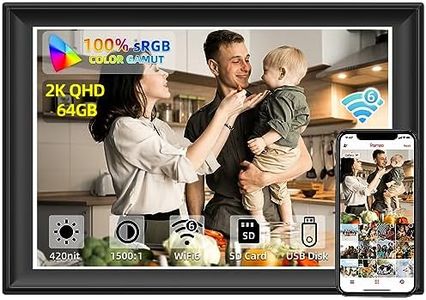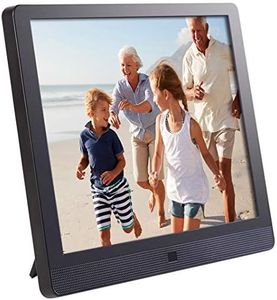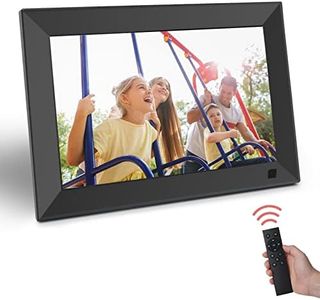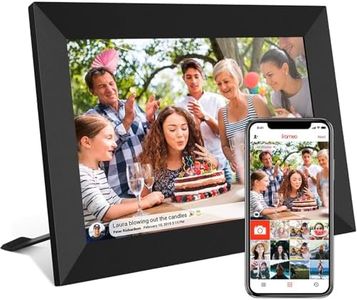We Use CookiesWe use cookies to enhance the security, performance,
functionality and for analytical and promotional activities. By continuing to browse this site you
are agreeing to our privacy policy
10 Best Digital Photo Frames
From leading brands and best sellers available on the web.By clicking on a link to a third party's website, log data is shared with that third party.
Buying Guide for the Best Digital Photo Frames
Choosing a digital photo frame is all about finding the right balance between how you want your memories to be displayed and where you plan to use the device. Start by imagining where in your home or office you'll place the frame and what kinds of photos you want to show—family pictures, travel memories, or even artistic images. Think about how easy you'd like the setup and photo transfer to be, and whether you'll be sharing the frame with others who may want to see fresh pictures regularly. By considering these factors, you can focus on the key specifications that will have the biggest impact on your photo experience.Display SizeDisplay size refers to the diagonal measurement of the screen, typically given in inches. This is important because it determines how large your photos will appear and how much space the frame will take up in your room. Sizes usually range from small tabletop frames (around 7 to 8 inches), medium frames for desks or shelves (between 10 and 12 inches), to large frames (15 inches or more) suitable for more prominent display areas like living rooms. Choose a size that fits the space where you plan to put your frame and makes your photos easily viewable from the expected distance.
ResolutionResolution describes how many pixels are used to display your images, and it affects how clear and sharp your photos will look. Lower resolutions can make pictures look grainy, especially on larger screens, while higher resolutions display more detail. Common resolutions for digital photo frames include 800x600, 1024x768, and Full HD (1920x1080). For smaller frames, lower resolutions may still look good, but for larger screens, opt for higher resolutions to best show off your photos. If you care a lot about image quality or have high-resolution photos to show, look for frames with higher pixel counts.
Storage CapacityStorage capacity indicates how many photos the frame can hold, either through built-in memory or added through an SD card or USB drive. Some frames have limited internal storage (like 2-8GB), while others rely mostly on removable memory or cloud storage. If you want to cycle through a lot of photos or video clips, opt for larger storage or cloud-supported frames. If you only need to display a smaller, static selection, even modest onboard storage can be sufficient. Think about how many photos you'd ideally want to display at once, and consider whether you want to frequently update your frame or leave it mostly unchanged.
Photo Transfer MethodThis refers to how you put new photos onto your frame. Common options include transferring files via USB, SD cards, or using Wi-Fi and apps to send images directly from smartphones or computers. Some advanced frames even allow family and friends to send photos remotely over the internet. If you want the simplest and quickest updates, consider a model with wireless transfer or app support. If you don't mind a more manual process, a basic frame that uses USB or SD cards may be sufficient. Your comfort with technology and how frequently you want to update photos should guide your choice here.
User Interface and ControlsThe user interface is about how you interact with the frame—adjusting settings, starting slideshows, or connecting to Wi-Fi. Some frames use simple buttons, others offer touchscreens, and some even come with remote controls. Choose a system that feels comfortable for you or anyone who will be using the frame. If you prefer straightforward operation, physical buttons or a remote may suit you. If you like modern controls and customization, a touchscreen interface can be helpful. Consider who will operate the frame—some seniors may appreciate simpler controls, while tech-savvy users might prefer more options.
Connectivity OptionsConnectivity options include Wi-Fi, Bluetooth, and compatibility with various apps or cloud services. Frames with Wi-Fi allow for remote management, online albums, and automatic updates of photo collections. Bluetooth may let you quickly send images from your phone. If you want seamless photo sharing from anywhere or wish to have family members contribute pictures remotely, look for frames with robust Wi-Fi and app integration. If you prefer a straightforward experience with direct transfers, you may not need advanced connectivity features.
Aspect RatioAspect ratio is the shape of the frame's screen, such as 4:3 or 16:9, and determines how digital photos appear without cropping or leaving empty spaces. Most smartphone and camera photos are in 4:3, while some are in 16:9 (widescreen). If most of your images are from phones or traditional cameras, a 4:3 frame will show them naturally. If you shoot mostly wide photos or video, a 16:9 ratio may be better. Picking a ratio that matches your photo sources keeps images looking their best.

















